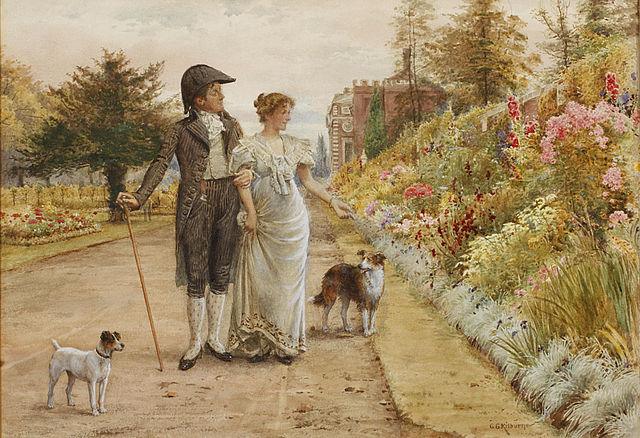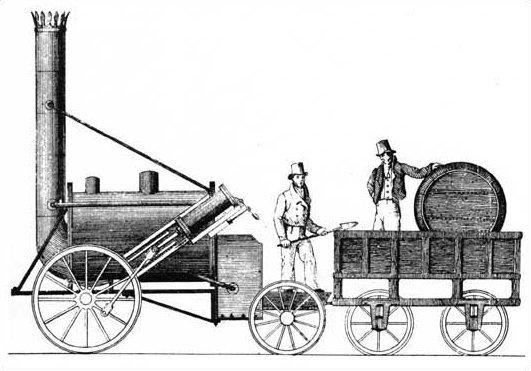Mr. Collins’s Garden
“…the chief of the time between breakfast and dinner was now passed by him (Mr. Collins) either at work in the garden, or in reading and writing, and looking out of window in his own book room, which fronted the road.” Chapter 30 Pride and Prejudice by Jane Austen
A vegetable garden and small orchard were a necessity for a country parson. The produce provided food for his table and helped to stretch a modest income. In Pride and Prejudice, we are also told that Mrs. Collins encouraged this occupation in order to gain a respite from her loquacious husband. 
When Mr. Collins gave Sir William, Elizabeth, and Maria a tour of his garden, Jane Austen is silent as to what they were shown. Indeed, why bore her contemporary readers with a list of well know plants that would hardly forward the plot of her romance. At a distance of some 200 years, we may well wonder what plants might have grown in Mr. Collins’s garden. Apple orchards have been a part of English gardens, since medieval times. If space was very tight, the trees may even have been espaliered to the garden walls. Sweet eating apples must come from grafted trees, since all apple seeds produce only tart apples. Grafting was well understood, since medieval times. Apples provided easily stored fruit for eating, cooking in tarts, and for ciders. In 1658, John Evelyn, the famous diarist, wrote The French Gardener: instructing how to cultivate all sorts of Fruit-trees, a how-to book on cultivating fruit trees.  Due to the wet climate, vegetables were often cultivated in raised beds that would drain well. Vegetable beds were created by surrounding an area with planks, staked to the ground and filled with earth.
Due to the wet climate, vegetables were often cultivated in raised beds that would drain well. Vegetable beds were created by surrounding an area with planks, staked to the ground and filled with earth.  Root crops might include potatoes and carrots. Potatoes were introduced to England from the New World in the late 16th century. Cold weather during the Icelandic volcanic eruptions, in the 1780s, helped to promote acceptance of the cold tolerant plant. Potatoes also store well in cool, dry, and dark rooms. Carrots came to England, from Holland, in the 1740s, and recipes for soups and puddings using carrots began to appear at that time, also. Mr. Collins probably grew pumpkins. The American plant was introduced to Tudor England by the French.
Root crops might include potatoes and carrots. Potatoes were introduced to England from the New World in the late 16th century. Cold weather during the Icelandic volcanic eruptions, in the 1780s, helped to promote acceptance of the cold tolerant plant. Potatoes also store well in cool, dry, and dark rooms. Carrots came to England, from Holland, in the 1740s, and recipes for soups and puddings using carrots began to appear at that time, also. Mr. Collins probably grew pumpkins. The American plant was introduced to Tudor England by the French.
However, Charlotte would most likely cook pumpkin by cutting off the top of the pumpkin, scooping out the seeds and filling it with a mixture of milk, honey, apples and spices. She would then replace the top and roast the entire pumpkin in hot ashes. Climbing vegetables, such as peas, were generally supported by cone shaped trellises made of bundles of willow branches, tied together near the top. Peas probably came to England with the Romans, since the English word has Latin origins. The green vegetable became very popular by the 17th century, particularly when served fresh. Peas can be dried and stored for long periods of time, making them a winter staple. Cucumbers were probably introduced to England by the Romans. Pickling is an ancient art, so Charlotte, who often helped in the kitchen at home, probably put up pickles. Curiously they were called cowcumbers at this time.  There would, almost certainly, be a row of cabbages in the garden Mr. Collins tended. Cabbages are supposed to have been spread by the Celts, so they had long been present in England. Greens such as lettuce and spinach would also have been planted in the garden. Lettuce probably arrived with the Romans. Spinach came to England from Spain in the 14th century, probably brought back by pilgrims who visited Santiago de Compostela. Salads dressed with vinaigrettes came into vogue, in England, after the French Revolution forced many French refugees to flee to England. Tomatoes would probably not be found in Mr. Collins’s garden.
There would, almost certainly, be a row of cabbages in the garden Mr. Collins tended. Cabbages are supposed to have been spread by the Celts, so they had long been present in England. Greens such as lettuce and spinach would also have been planted in the garden. Lettuce probably arrived with the Romans. Spinach came to England from Spain in the 14th century, probably brought back by pilgrims who visited Santiago de Compostela. Salads dressed with vinaigrettes came into vogue, in England, after the French Revolution forced many French refugees to flee to England. Tomatoes would probably not be found in Mr. Collins’s garden.
Many people believed that they were poisonous and would not eat them, because they belong to the nightshade family. Tomatoes were not widely eaten until the 1820s. Herbs would have been important plants in any garden of this period. Lavender would be grown and dried, for use in sachets, to be placed in cloths chests. Lavender smells nice but prevents the ravages of insects on clothing made of natural fibers, as all clothes, at that time were. Lavender was also used in soap making. Mint was used in sachets and in cooking. Dill would have been used in pickling and sprinkled over some breads. The parsley, sage, rosemary, and thyme of the old song would also have grown in the garden. Parsley had come to England by Elizabethan times and was an important garnish and ingredient by Jane Austen’s time. Sage was already used with fatty meats such as sausage, and with sage Derby cheese.
Surprising, sage was also used as a tea. Rosemary was commonly used as an aromatic herb, as a hair rinse and to season lamb. Thyme probably arrived with the Romans. The herb was used on meats and in stews. It was also burnt as incense. The walkway approaching the house would probably have been surrounded by flowers and shrubs. However, we would not see roses or bulb flowers, which were still expensive imports, in Jane Austen’s day. Fruit trees and native foxgloves and hollyhocks would be the most likely decorative plantings at a country parson’s house. Hollyhock seeds had come back from the crusades, in the crusader’s saddle bags, and were long established in England.  Though a tour of Mr. Collins’s garden, may seem a bit silent without commentary from Mr. Collins, hopefully a good idea of the similarities and differences of that time and place was conveyed. I beg you will forgive me, for taking over that earnest man’s role.
Though a tour of Mr. Collins’s garden, may seem a bit silent without commentary from Mr. Collins, hopefully a good idea of the similarities and differences of that time and place was conveyed. I beg you will forgive me, for taking over that earnest man’s role.
Written for the Jane Austen Online Magazine Sharon Wagoner, Curator of The Georgian Index. Visit her site for a historical tour through Regency London. Her novel, The Coronation, is available for free, for the Amazon kindle.
Enjoyed this article? If you don't want to miss a beat when it comes to Jane Austen, make sure you are signed up to the Jane Austen newsletter for exclusive updates and discounts from our Online Gift Shop.



Leave a comment
This site is protected by hCaptcha and the hCaptcha Privacy Policy and Terms of Service apply.